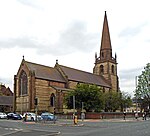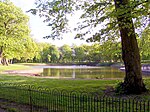Breck Road railway station
Disused railway stations in LiverpoolFormer London and North Western Railway stationsMerseyside railway station stubsPages with no open date in Infobox stationRailway stations in Great Britain closed in 1948 ... and 2 more
Railway stations in Great Britain opened in 1870Use British English from August 2012

Breck Road railway station was located on the Canada Dock Branch to the north of Townsend Lane between Anfield and Clubmoor, Liverpool, England. It opened on 1 July 1870 and closed on 31 May 1948. By 2017 the only trace of the station was a bricked-up entrance at street level, but freight trains to and from Seaforth Dock still pass through the station site over the bridge. It was announced in December 2019 that Liverpool City Council had commissioned a feasibility study to see about reopening the Canada Dock Branch to passenger traffic.
Excerpt from the Wikipedia article Breck Road railway station (License: CC BY-SA 3.0, Authors, Images).Breck Road railway station
Townsend Avenue, Liverpool Clubmoor
Geographical coordinates (GPS) Address Nearby Places Show on map
Geographical coordinates (GPS)
| Latitude | Longitude |
|---|---|
| N 53.4327 ° | E -2.9401 ° |
Address
Townsend Avenue
L6 0DG Liverpool, Clubmoor
England, United Kingdom
Open on Google Maps






